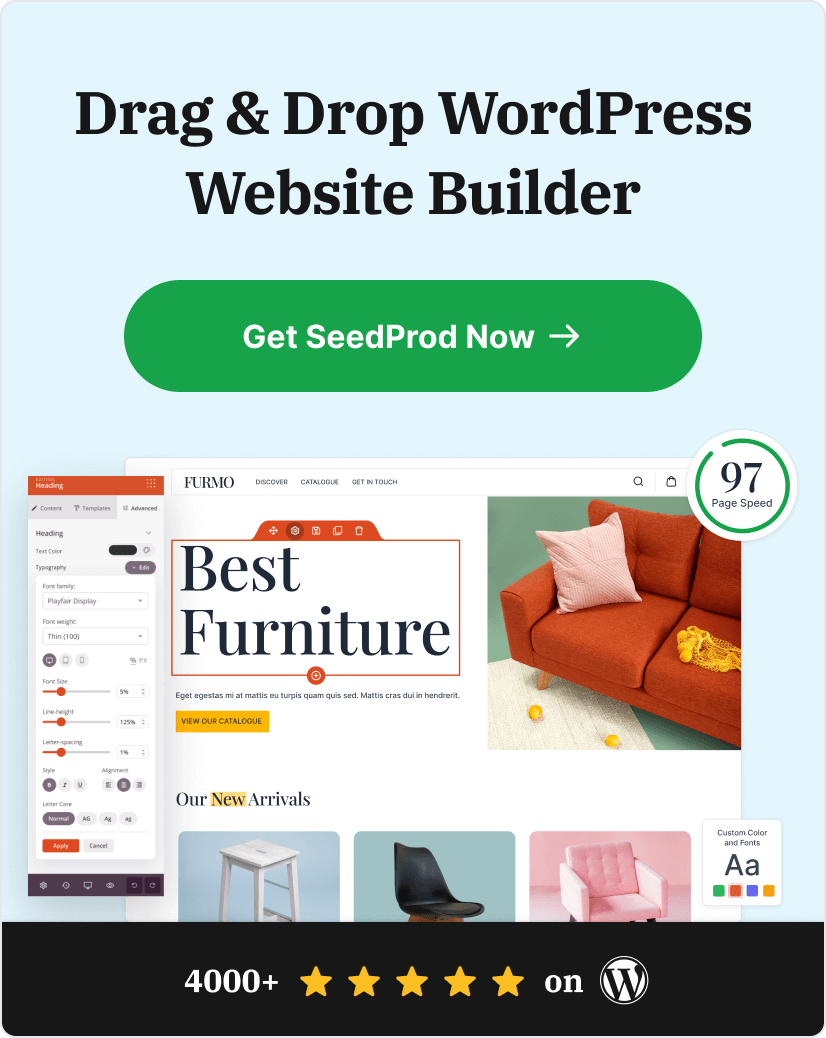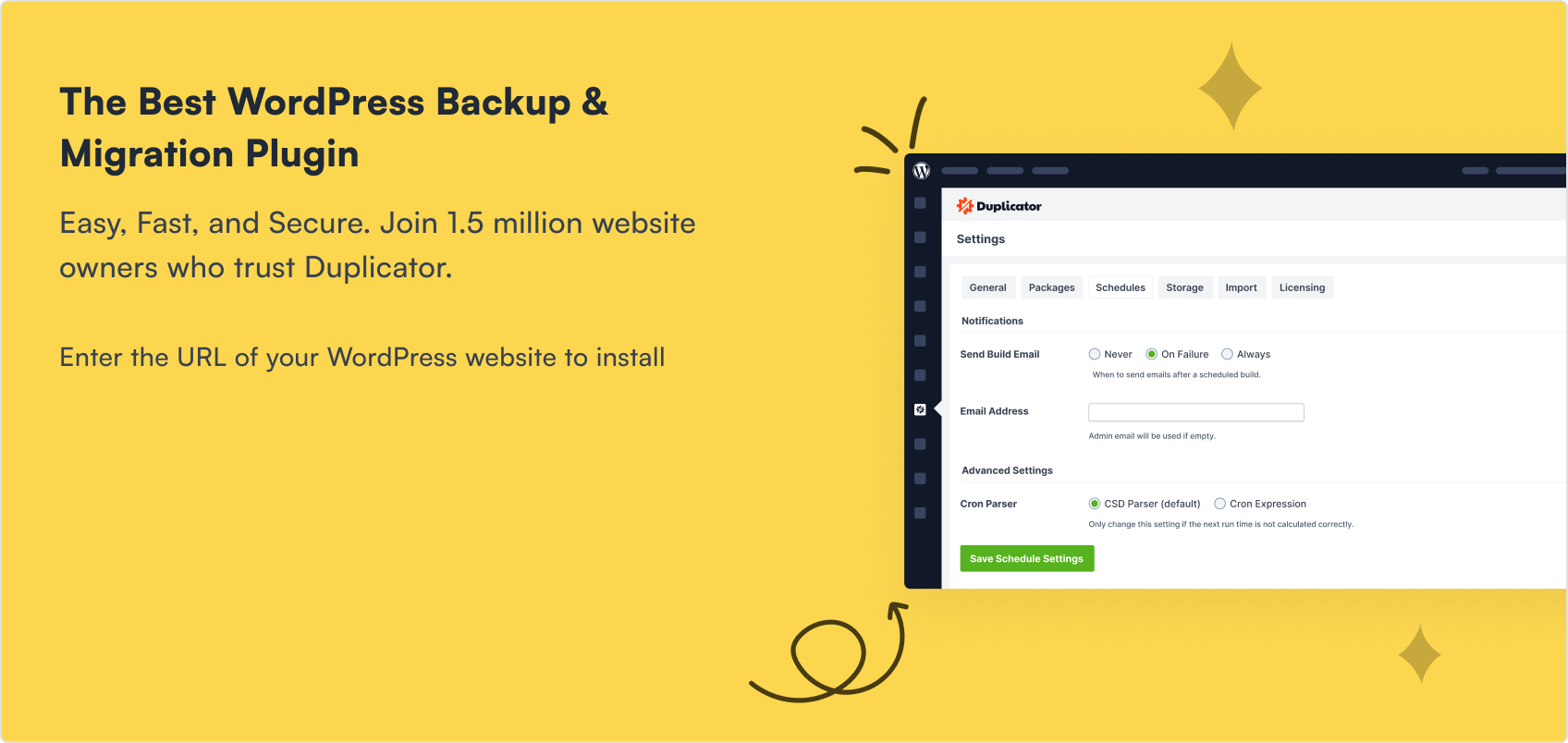Are you looking for the best FAQ pages to inspire your next design? A well-built FAQ page doesn’t just answer questions — it saves customer support time, builds trust, and even turns more visitors into customers.
In this guide, I’ll show you real examples of the best FAQ pages, break down what makes them work, and share a simple framework you can follow to create one for your own site. You’ll also see what other industries, like retail and healthcare, can teach us about designing FAQs that are clear, trustworthy, and conversion-focused.
By the end, you’ll know exactly how to design a FAQ page that checks all the right boxes. I’ll also show you the easiest way to build one in WordPress.
Jump to the best FAQ pages:
- 1. Dropbox
- 2. Pinterest
- 3. Twitter (X)
- 4. Nintendo Switch
- 5. Etsy
- 6. McDonald's UK
- 7. Lego VIP
- 8. Pure App
- 9. Potion
- 10. First Direct
- 11. Headspace
Why Do You Need a FAQ Page?
A FAQ page does more than answer common questions. It saves time for your support team, builds trust with visitors, and helps remove objections that stop people from buying.
Here are a few key reasons every website can benefit from a FAQ page:
- Saves time: Customers can find quick answers without waiting on support, and your team spends less time answering repeat questions.
- Builds trust: Showing you understand customer pain points makes visitors more confident in choosing your product or service.
- Reduces complaints: Clear answers to shipping, returns, or policy questions prevent confusion and negative reviews.
- Improves SEO: Optimized FAQ pages often appear in Google results, giving you more visibility and traffic to related product pages.
In short, a strong FAQ page improves both customer experience and conversions, and the best ones do it by following a few simple principles.
What Makes a Good FAQ Page?
A good FAQ page is clear, easy to navigate, and regularly updated. While the goal is to answer common questions, the best FAQ pages also improve user experience and guide visitors toward the next step on their journey.
Here are some best practices to keep in mind when creating or improving your FAQ page:
- Organized layout: Use categories, accordions, or anchor links so visitors can find answers quickly.
- Clear language: Keep answers short and direct, linking to more detailed resources if needed.
- Regular updates: Add or edit questions as your business, products, or policies change.
- Prioritized questions: Place your most common or important questions at the top of the page.
- Search option: Consider adding a site search feature for quick navigation.
- Helpful links: Point to related guides, support docs, or product pages to move users forward.
Adding FAQ schema is still a smart move, even though Google no longer displays FAQ snippets in search results. Schema helps search engines better understand your content, supports accessibility tools, and can improve visibility in AI-powered results and voice search.
Beyond these basics, the best FAQ pages also share a few deeper traits that make them stand out. Let’s look at the five pillars that consistently appear across high-performing FAQ designs.
The 5 Pillars of High-Converting FAQ Pages
From looking at some of the best FAQ pages across industries, I’ve found they all share five traits.

Use these pillars as a quick checklist when designing your own FAQ page:
- Findability: Make answers easy to locate with categories, search bars, or accordions.
- Clarity: Keep answers short, clear, and free of jargon, with links to more detail if needed.
- Trust: Show consistency and credibility with accurate, up-to-date information.
- Conversion: Add subtle CTAs or product links to guide visitors toward the next step.
- Evolution: Keep your FAQ page fresh by updating it regularly based on customer questions.
When your FAQ page covers all five pillars, it becomes more than a support tool — it turns into a trust-builder and conversion driver. Let’s look at some real examples that put these ideas into practice.
Best FAQ Page Examples and Ideas
Now let’s look at some excellent FAQ page examples from which you can learn and take inspiration.
1. Dropbox
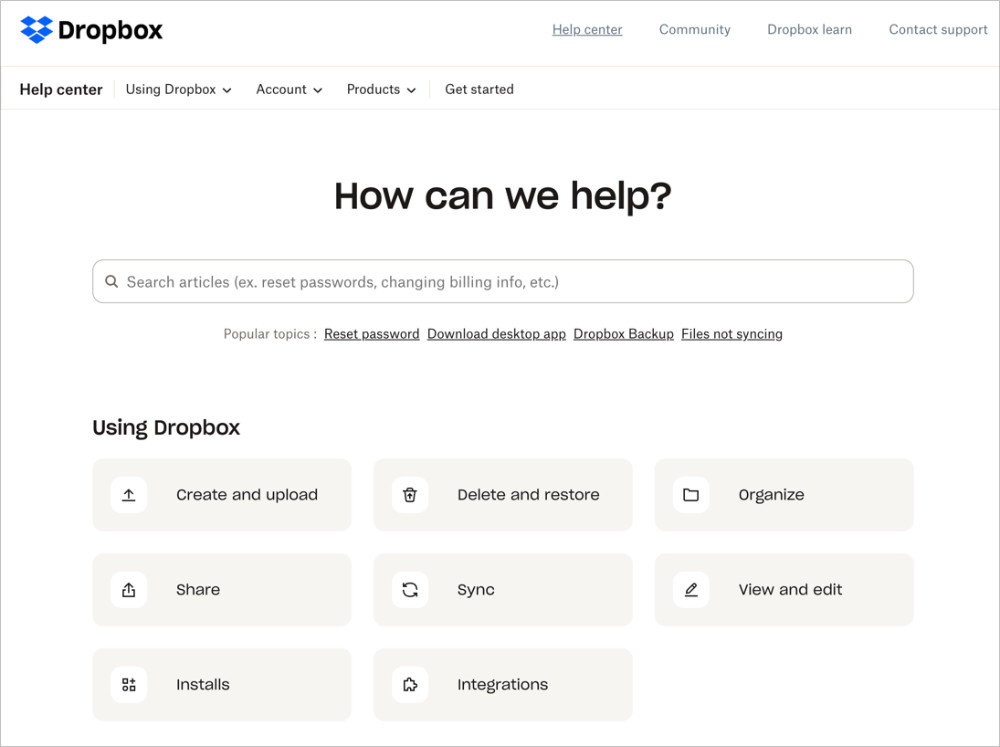
Dropbox’s FAQ page combines clean design with strong findability. The most common questions sit at the top, while a search bar and clear categories make it easy for users to dive deeper.
It also scores highly on clarity — answers are short, simple, and link to detailed guides when needed. The only weak spot is conversion, since there are few calls-to-action within the page.
Takeaway: This is a great model if you want your FAQ page to prioritize fast answers and usability above everything else.
2. Pinterest

Pinterest’s FAQ page takes a search-first approach. A bold search bar dominates the top, while categories and quick links guide users to common topics.

The featured articles accordion doubles as a soft conversion element, encouraging users to explore tutorials and tips that deepen their use of the platform. This makes it strong on findability, clarity, and even conversion.
Takeaway: Pinterest shows how an FAQ page can support both quick problem-solving and gentle onboarding, helping users stay engaged with the product.
3. Twitter (X)
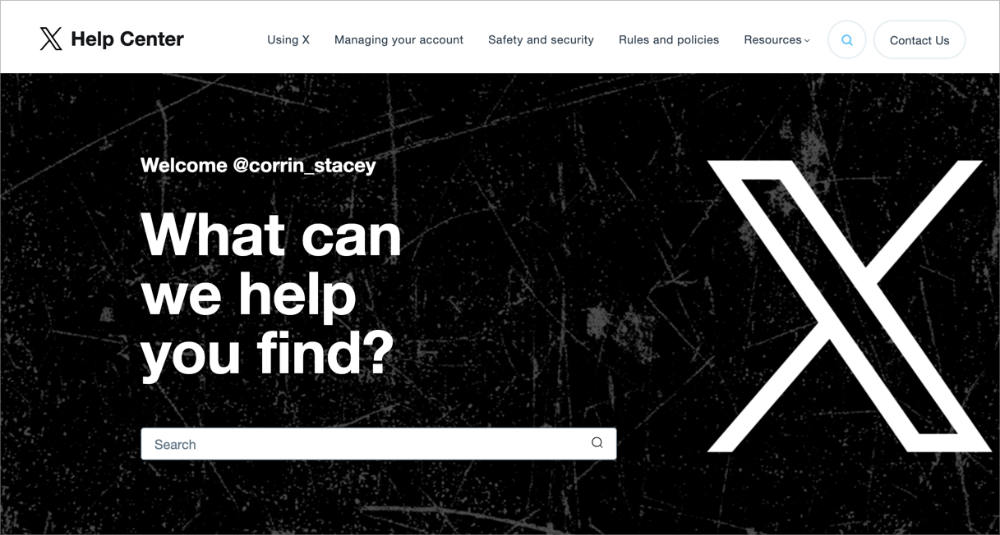
Twitter’s help center takes a straightforward approach with a prominent search bar at the top and neatly organized categories beneath it. This structure makes answers easy to find, highlighting the findability pillar.
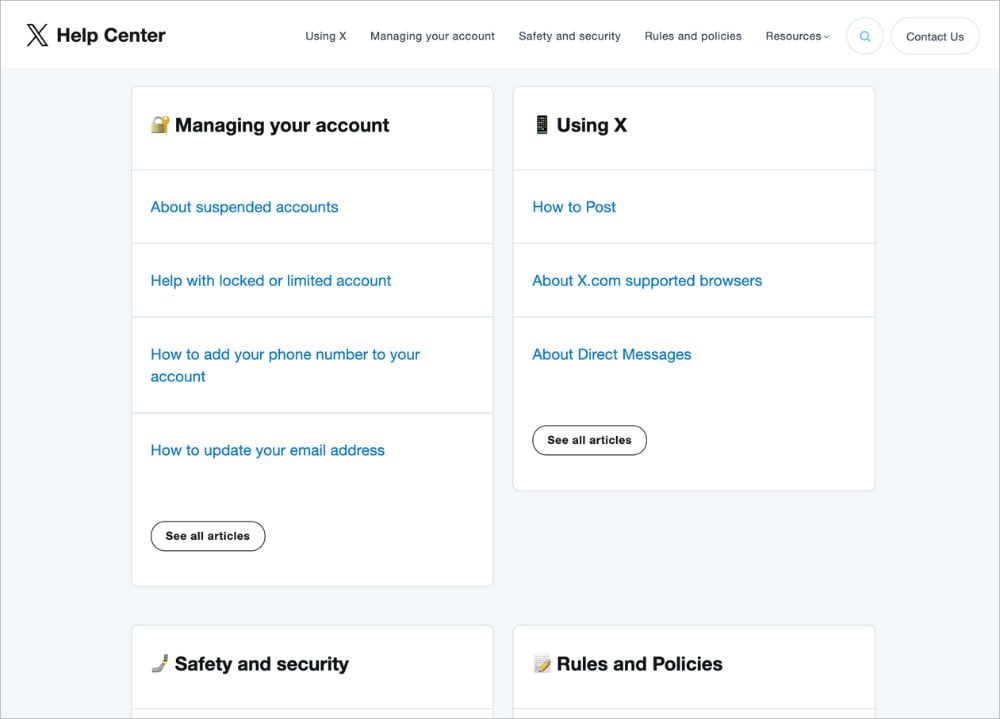
The layout is uniform and distraction-free, which adds clarity. However, like many FAQ pages, it has limited conversion elements since the focus is purely on support content.
Takeaway: Twitter’s FAQ is a clean, no-frills design that works well if your main goal is to reduce support requests with clear navigation and simple answers.
4. Nintendo Switch

Nintendo Switch keeps its FAQ page simple and highly accessible, which is important since the audience includes both adults and younger users. Visual icons link directly to the most common questions, boosting findability without overwhelming visitors.
The accordion design allows questions to expand and collapse, which supports clarity by keeping the layout clean on both desktop and mobile. The page is light on conversion elements, but excels at quick problem-solving.
Takeaway: Nintendo’s FAQ page shows the value of simplicity — if your audience spans different age groups, straightforward navigation and visual cues can make the experience more user-friendly.
5. Etsy
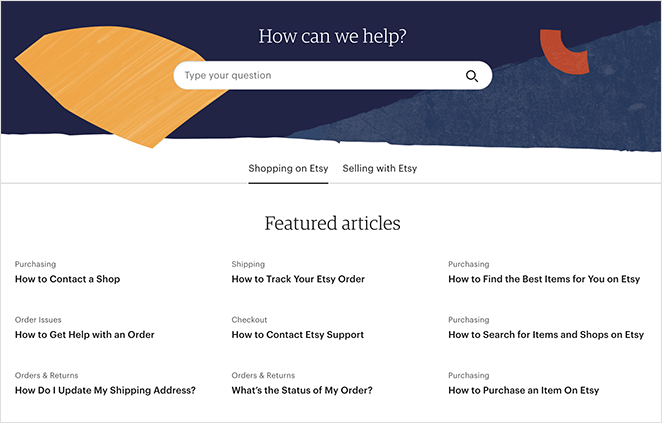
Etsy’s FAQ page is clean and professional, with a search bar at the top and featured articles grouped by topic. This makes it strong on findability and clarity, helping shoppers and sellers quickly locate the information they need.
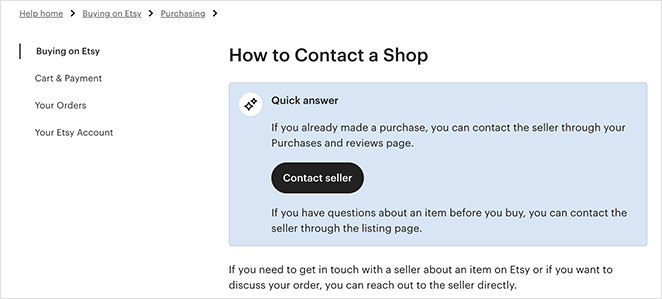
Each article includes links to related topics and calls-to-action for contacting support, which adds a conversion element. Consistent branding and regular updates also contribute to trust and evolution.
Takeaway: Etsy’s FAQ page is a good model for eCommerce businesses, showing how to balance clarity with helpful links that move users toward the next step.
6. McDonald’s UK
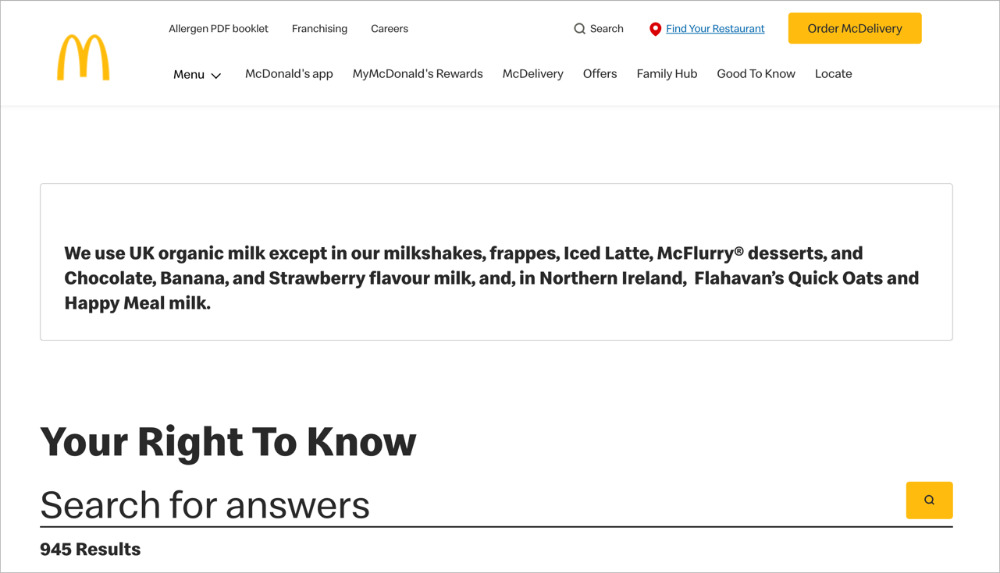
McDonald’s UK offers a tidy help center with multiple ways to find answers. A search bar sits up top, and filters let you narrow by category. This strongly supports findability.
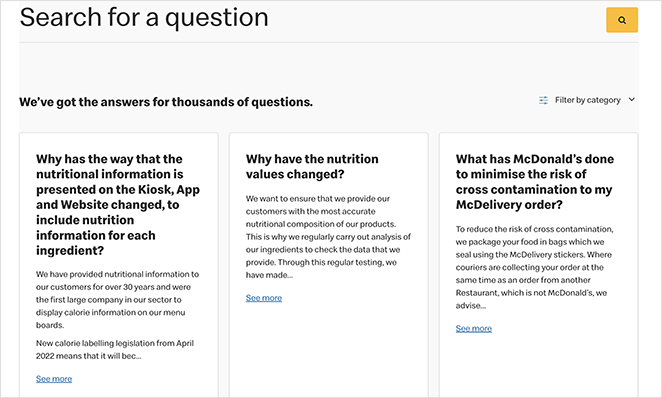
The layout is compact and easy to scan on mobile, reinforcing clarity. The “Load more” pattern keeps the page short while still giving access to deeper content.
Clear policy details and consistent branding build trust. It’s light on direct conversion CTAs, but links to contact options and related topics help users take the next step.
Takeaway: If you serve a broad audience, prioritize fast search, simple filters, and mobile-friendly layouts to reduce friction and support quick problem-solving.
7. Lego VIP
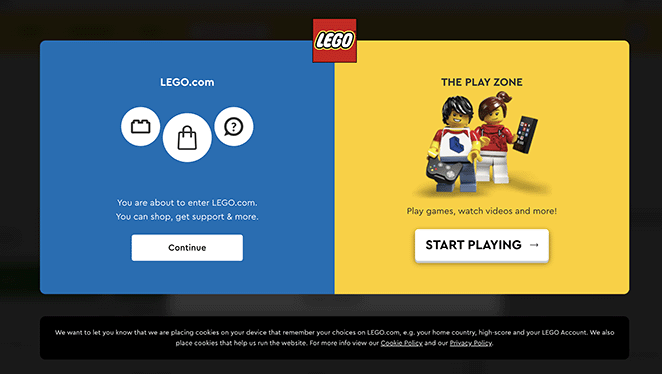
Lego’s help center recognizes different user goals from the start, offering clear pathways to the main site or the play zone. This smart routing supports findability by sending visitors to the right place fast.
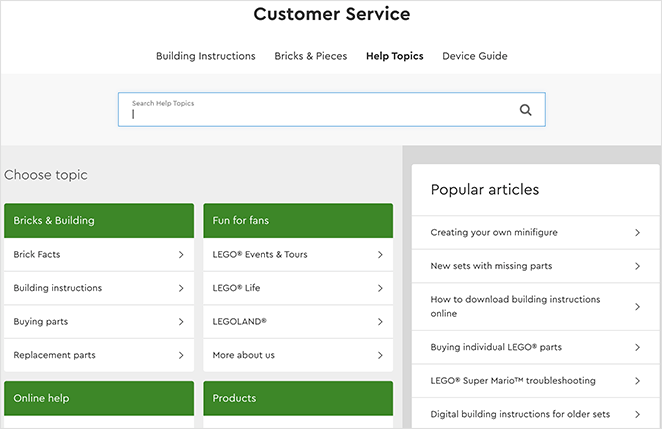
Inside the knowledge base, topics are grouped with a search bar and popular articles in the sidebar, which boosts clarity. Multiple contact options (email, live chat, phone, mail) add trust and gently support conversion by guiding users to help when self-serve falls short.
Takeaway: If your audience includes parents and kids with very different needs, offer clear paths for each and keep help options easy to find.
8. Pure App
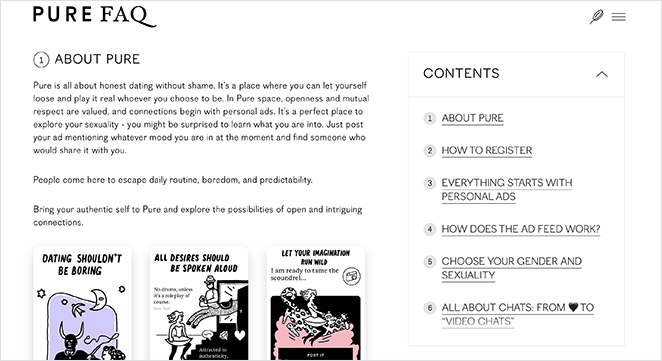
Pure App uses a minimalist, single-page FAQ design divided into numbered sections. This gives it solid clarity, since users can either scroll or use the table of contents to jump to what they need.
Screenshots throughout the answers add visual context, while links to detailed articles support findability. However, the lack of accordions or collapsible sections makes it a little harder to scan on mobile.
Takeaway: If your FAQ content is straightforward and text-based, a minimalist design like Pure App’s works well. Just consider adding collapsible sections for better mobile usability.
9. Potion
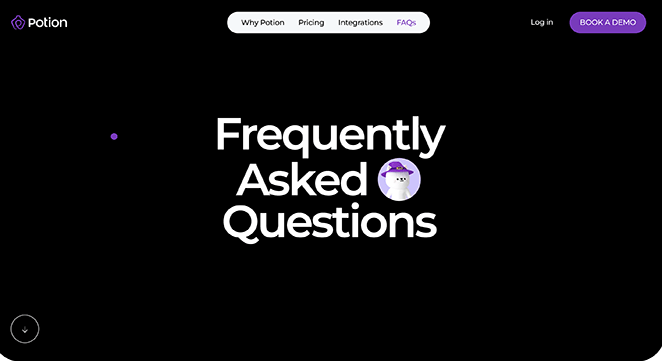
Potion’s FAQ page combines playful design with strong usability. The expanding accordion format gives it excellent findability and clarity, since visitors can browse questions without feeling overwhelmed.

Larger fonts and a fully mobile-friendly design boost accessibility, while the quirky cursor and branding details add trust by keeping the experience on-brand. It’s light on conversion cues, but excels at user experience.
Takeaway: Potion proves that FAQ pages don’t have to be boring. If your brand personality is fun or creative, reflect it in your FAQ design while keeping usability front and center.
10. First Direct
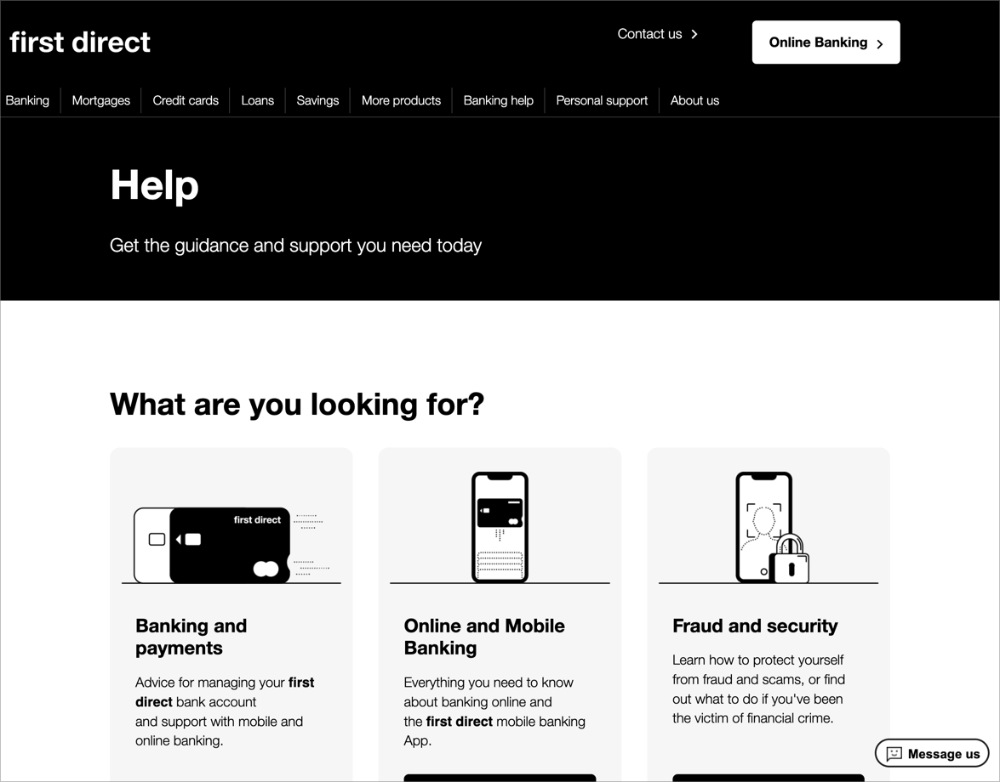
First Direct keeps things straightforward with popular questions at the top and expandable sections beneath. This makes answers quick to scan and strongly supports findability and clarity.

Clear categories (like accounts, security, payments) and occasional embedded videos add context and build trust. Internal links guide users to deeper help, though direct conversion prompts are minimal.
Takeaway: If your topic is complex or regulated (like banking), combine simple navigation with short answers and deeper resources to keep users confident and moving forward.
11. Headspace
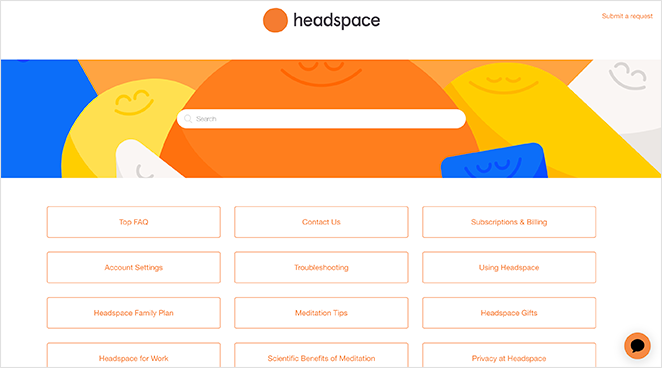
Headspace’s FAQ page is vibrant and on-brand, immediately building trust with visitors. A clear search bar sits at the top, while clickable topic boxes make navigation easy, strengthening findability.
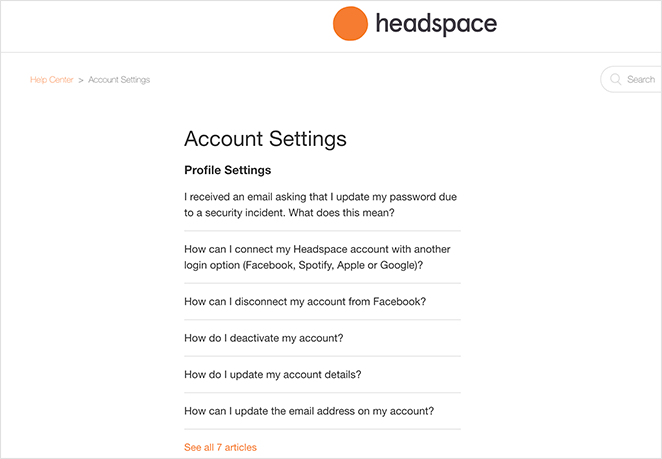
Each subtopic leads to more detailed answers, which supports clarity. The design is calm, consistent, and aligned with the app’s purpose, making the whole page feel approachable and trustworthy.
Takeaway: If brand identity is central to your business, follow Headspace’s example. Let your FAQ page reflect your style while still keeping answers clear and easy to navigate.
How These FAQ Pages Measure Up
Here’s how a few of the top FAQ pages in this guide measure up against my 5 Pillars framework:
| FAQ Example | Findability | Clarity | Trust | Conversion | Evolution |
|---|---|---|---|---|---|
| Dropbox | ✅ Search + categories | ✅ Simple answers | ✅ Consistent branding | ➖ Few CTAs | ✅ Regular updates |
| ✅ Search-first design | ✅ Short, direct answers | ➖ Minimal authority cues | ✅ Featured articles act as soft conversion | ✅ Ongoing content additions | |
| Etsy | ✅ Search + categories | ✅ Clear topic clusters | ✅ Strong branding & credibility | ✅ Contact CTAs + links | ✅ Regular article updates |
Dropbox and Pinterest excel at making information easy to find, while Etsy balances all five pillars by combining clarity, trust, and conversion. The best FAQ pages succeed when they cover more than just one or two pillars.
How to Create a FAQ Page in WordPress?
Now that you know more about FAQ pages, you probably want to jump in and make one for your website. While you can use a WordPress FAQ plugin, the easiest way to add a FAQ page to your WordPress site is with a drag-and-drop page builder plugin, like SeedProd.
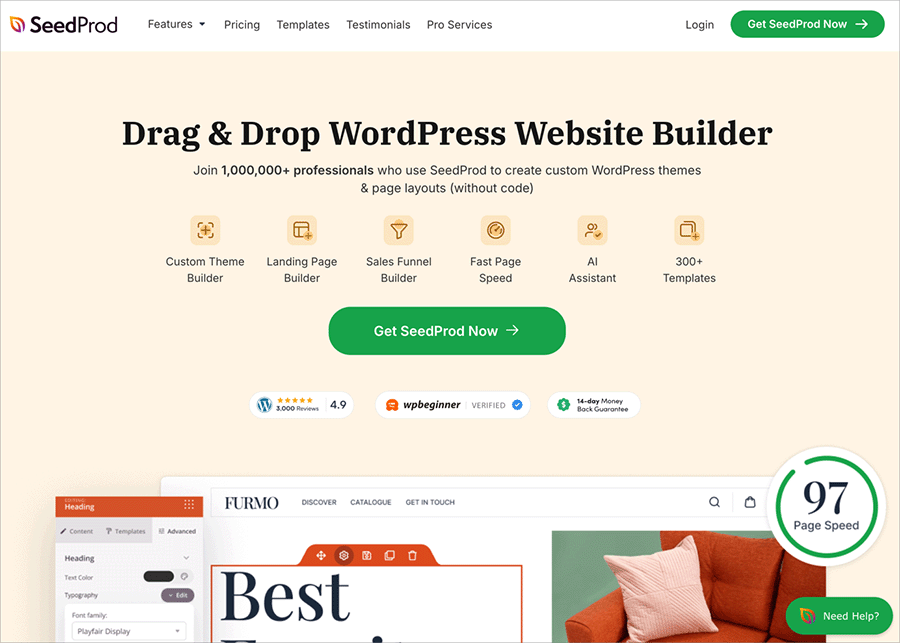
SeedProd is the best website builder for WordPress. It lets you create WordPress themes, landing pages, and flexible layouts for your WordPress site without code.
SeedProd includes everything you need to create an optimal FAQ page design, such as:
- Premade landing page templates
- Ready-to-use FAQ sections
- Accordions to expand and hide answers
- Built-in search bars for finding answers quickly
- Anchor links to jump to relevant FAQs
You can also customize any part of your page in the visual editor, saving you spending time and money on a developer.
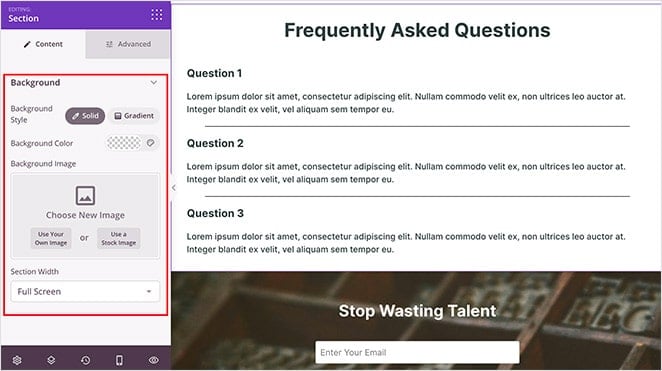
Here’s a step-by-step guide on creating a FAQ page with SeedProd. Or, if you’d like to jump right in, click the button below.
FAQs on Building the Best FAQ Pages
I hope this article helped you find the best FAQ pages, examples, and ideas. You might also like these other helpful guides:
- How to Make a Page Full Width in WordPress
- 8 Best WordPress Accordion Plugins for FAQ
- 25+ Best WordPress Plugins to Revamp Your Site
Thanks for reading! We’d love to hear your thoughts, so please feel free to join the conversation on YouTube, X and Facebook for more helpful advice and content to grow your business.



